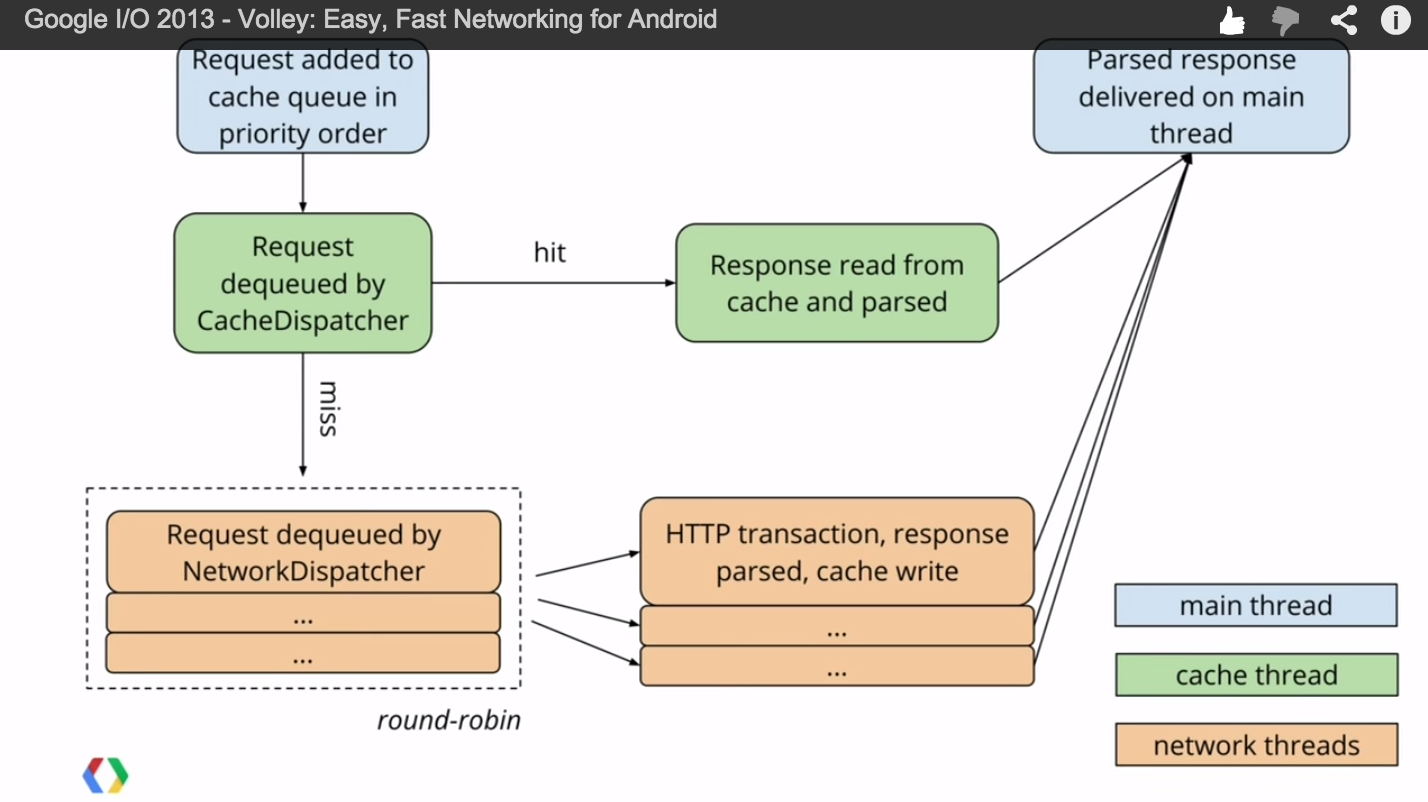安卓中使用Volley库发送HTTP请求 Android开发中使用Volley库发送HTTP请求的实例教程
人气:0Android Volley 是Google开发的一个网络lib,可以让你更加简单并且快速的访问网络数据。Volley库的网络请求都是异步的,你不必担心异步处理问题。
Volley的优点:
- 请求队列和请求优先级
- 请求Cache和内存管理
- 扩展性性强
- 可以取消请求
下载和编译volley.jar
需要安装git,ant,android sdk
clone代码:
git clone https://android.googlesource.com/platform/frameworks/volley
编译jar:
android update project -p . ant jar
添加volley.jar到你的项目中
不过已经有人将volley的代码放到github上了:
https://github.com/mcxiaoke/android-volley,你可以使用更加简单的方式来使用volley:
Maven
format: jar
<dependency> <groupId>com.mcxiaoke.volley</groupId> <artifactId>library</artifactId> <version>1.0.6</version> </dependency>
Gradle
format: jar
compile 'com.mcxiaoke.volley:library:1.0.6'
Volley工作原理图

创建Volley 单例
使用volley时,必须要创建一个请求队列RequestQueue,使用请求队列的最佳方式就是将它做成一个单例,整个app使用这么一个请求队列。
public class AppController extends Application {
public static final String TAG = AppController.class
.getSimpleName();
private RequestQueue mRequestQueue;
private ImageLoader mImageLoader;
private static AppController mInstance;
@Override
public void onCreate() {
super.onCreate();
mInstance = this;
}
public static synchronized AppController getInstance() {
return mInstance;
}
public RequestQueue getRequestQueue() {
if (mRequestQueue == null) {
mRequestQueue = Volley.newRequestQueue(getApplicationContext());
}
return mRequestQueue;
}
public ImageLoader getImageLoader() {
getRequestQueue();
if (mImageLoader == null) {
mImageLoader = new ImageLoader(this.mRequestQueue,
new LruBitmapCache());
}
return this.mImageLoader;
}
public <T> void addToRequestQueue(Request<T> req, String tag) {
// set the default tag if tag is empty
req.setTag(TextUtils.isEmpty(tag) ? TAG : tag);
getRequestQueue().add(req);
}
public <T> void addToRequestQueue(Request<T> req) {
req.setTag(TAG);
getRequestQueue().add(req);
}
public void cancelPendingRequests(Object tag) {
if (mRequestQueue != null) {
mRequestQueue.cancelAll(tag);
}
}
}
另外,你还需要一个Cache来存放请求的图片:
public class LruBitmapCache extends LruCache<String, Bitmap> implement ImageCache {
public static int getDefaultLruCacheSize() {
final int maxMemory = (int) (Runtime.getRuntime().maxMemory() / 1024);
final int cacheSize = maxMemory / 8;
return cacheSize;
}
public LruBitmapCache() {
this(getDefaultLruCacheSize());
}
public LruBitmapCache(int sizeInKiloBytes) {
super(sizeInKiloBytes);
}
@Override
protected int sizeOf(String key, Bitmap value) {
return value.getRowBytes() * value.getHeight() / 1024;
}
@Override
public Bitmap getBitmap(String url) {
return get(url);
}
@Override
public void putBitmap(String url, Bitmap bitmap) {
put(url, bitmap);
}
}
别忘记在AndroidManifest.xml文件中添加android.permission.INTERNET权限。
HTTP请求实例
private Context mContext;
private RequestQueue mRequestQueue;
private StringRequest mStringRequest;
// 利用Volley实现Post请求
private void volley_post() {
String url = "http://aplesson.com/wap/api/user.php?action=login";
mContext = this;
mRequestQueue = Volley.newRequestQueue(mContext);
mStringRequest = new StringRequest(Method.POST, url,
new Response.Listener<String>() {
@Override
public void onResponse(String response) {
System.out.println("请求结果:" + response);
}
}, new Response.ErrorListener() {
@Override
public void onErrorResponse(VolleyError error) {
System.out.println("请求错误:" + error.toString());
}
}) {
// 携带参数
@Override
protected HashMap<String, String> getParams()
throws AuthFailureError {
HashMap<String, String> hashMap = new HashMap<String, String>();
hashMap.put("un", "852041173");
hashMap.put("pw", "852041173abc");
return hashMap;
}
// Volley请求类提供了一个 getHeaders()的方法,重载这个方法可以自定义HTTP 的头信息。(也可不实现)
public Map<String, String> getHeaders() throws AuthFailureError {
HashMap<String, String> headers = new HashMap<String, String>();
headers.put("Accept", "application/json");
headers.put("Content-Type", "application/json; charset=UTF-8");
return headers;
}
};
mRequestQueue.add(mStringRequest);
}
private JsonObjectRequest mJsonObjectRequest;
// 利用Volley实现Json数据请求
private void volley_json() {
mContext = this;
String url = "http://aplesson.com/data/101010100.html";
// 1 创建RequestQueue对象
mRequestQueue = Volley.newRequestQueue(mContext);
// 2 创建JsonObjectRequest对象
mJsonObjectRequest = new JsonObjectRequest(url, null,
new Response.Listener<JSONObject>() {
@Override
public void onResponse(JSONObject response) {
System.out.println("请求结果:" + response.toString());
}
}, new Response.ErrorListener() {
@Override
public void onErrorResponse(VolleyError error) {
System.out.println("请求错误:" + error.toString());
}
});
// 3 将JsonObjectRequest添加到RequestQueue
mRequestQueue.add(mJsonObjectRequest);
}
// 利用Volley实现Get请求
private void volley_get() {
mContext = this;
String url = "http://www.aplesson.com/";
// 1 创建RequestQueue对象
mRequestQueue = Volley.newRequestQueue(mContext);
// 2 创建StringRequest对象
mStringRequest = new StringRequest(url,
new Response.Listener<String>() {
@Override
public void onResponse(String response) {
System.out.println("请求结果:" + response);
}
}, new Response.ErrorListener() {
@Override
public void onErrorResponse(VolleyError error) {
System.out.println("请求错误:" + error.toString());
}
});
// 3 将StringRequest添加到RequestQueue
mRequestQueue.add(mStringRequest);
}
Volley提供了JsonObjectRequest、JsonArrayRequest、StringRequest等Request形式。JsonObjectRequest:返回JSON对象。
JsonArrayRequest:返回JsonArray。
StringRequest:返回String,这样可以自己处理数据,更加灵活。
另外可以继承Request<T>自定义Request。
取消Request
Activity里面启动了网络请求,而在这个网络请求还没返回结果的时候,Activity被结束了,此时如果继续使用其中的Context等,除了无辜的浪费CPU,电池,网络等资源,有可能还会导致程序crash,所以,我们需要处理这种一场情况。使用Volley的话,我们可以在Activity停止的时候,同时取消所有或部分未完成的网络请求。Volley里所有的请求结果会返回给主进程,如果在主进程里取消了某些请求,则这些请求将不会被返回给主线程。Volley支持多种request取消方式。
可以针对某些个request做取消操作:
@Override
public void onStop() {
for (Request <?> req : mRequestQueue) {
req.cancel();
}
}
取消这个队列里的所有请求:
@Override
protected void onStop() {
// TODO Auto-generated method stub
super.onStop();
mRequestQueue.cancelAll(this);
}
可以根据RequestFilter或者Tag来终止某些请求
@Override
protected void onStop() {
// TODO Auto-generated method stub
super.onStop();
mRequestQueue.cancelAll( new RequestFilter() {});
or
mRequestQueue.cancelAll(new Object());
}
Volley支持http的GET、POST、PUT、DELETE等方法。
加载全部内容